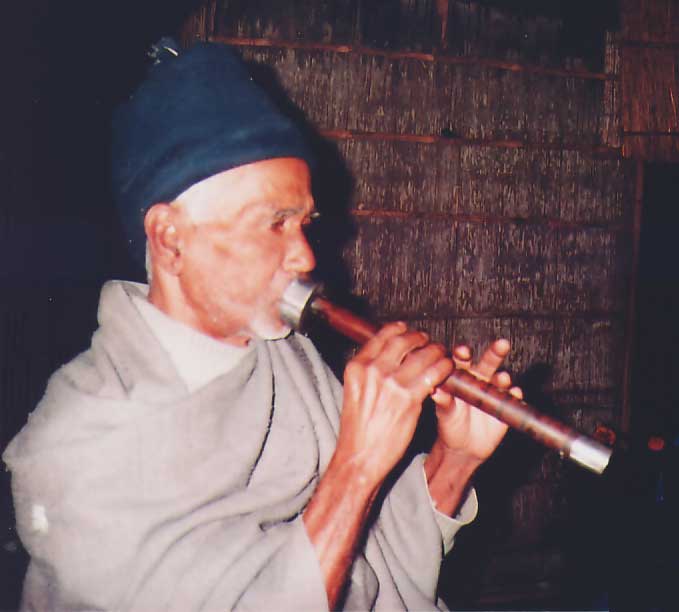
|
|
The bommbanshi or Bombashi is a
fipple flute found in Bangladesh. It is used in a variety of
folk music, such as the
vaoiaya (bhawaia) and the accompaniment of traditional This instrument does not have a wide distribution. Where some instruments may be found throughout south Asia, the bombashi is found only in the Dharla (A.K.A. Dhorla, Dhola) river basin area of Bangladesh. At the time of writing (2007), a total of only seven Bommbanshi players could be found in this region.
RELIGIOUS AND SOCIAL SIGNIFICANCEThis instrument has a strong social and religious significance. The social significance is derived from its association with the Poddopuran folk theatre. In this form of theatre, it along with the khol and mondira (a.k.a. Pena), are indispensable in providing the musical accompaniment. This theatre is an important way in which the people of Dharla River basin maintain a sense of cultural identity. The religious significance is seen in this flute's connection with the Hindu Goddess Monosha (a.k.a. Manasha). The traditional Poddopuran theatre is based on "Monosha" who is the snake goddess, appears to be a entrant into the ever assimilating pantheon of Hindu religion. (She is non Aryans' goddess). She is not mentioned in the Mahabharata, and the principal older purans. But she occupies considerable space in the Brahmavaivartapurana, a comparatively later work, the compilation of which continued till about the 16th century C.E. (ref. R. C. Hazra, Studies in the Puranic records on Hindu Rites and Customs, Dacca, 1940, p.166 and Brahmavaivartapurana, ed. and tr. by P. Tarkaratna, Calcutta, 1904, Prakrikhadam, 1.68.).
CONSTRUCTIONThe construction of the Bombashi is rather simple. It is made of a body of bamboo with a detachable round mouthpiece.  Body - The body is a length of bamboo that has an opening for the fipple and a number of holes. Body length is about 32 - 36 cm., body radius is about 9 - 11cm. Its one side is open and the other side is closed like any simple bamboo flute or bansuri(banshi). There are eight holes burned into the bamboo. There is one hole for blowing, this is the sound hole known as the Mukhkho rondhro (Literally "mouth hole"). This is also known in the local Rajbangsi dialect as the "fuker chanda". There are also seven finger holes. These are known as "shorrondhro". They are also referred to as "surer chanda" ("sur" means melody, "er" means of, "chanda" means hole). As with other fipple flutes, the fashioning of the fipple is critical. The closed side radius is slightly narrowed down with a knife by about 1 cm. Here the mouthpiece is fitted over it. Actually tuning technique depends on how you fit the Shama and how much you cover the hole area of Mukhkho rondhro (fuker chanda). The body of the bombashi is made from bamboo. They call it here "Bomm-Bashi" that is big flute, made of bamboo. This is to distinguish it from other flutes which are made from Benu- bansh or Tollah-bansh. The bombashi is made of "Maklabansh" a tougher bamboo of the Dharla (Dhorla) river basin. Mouth-Piece - The most striking part of the Bambashi is the large torodal mouthpiece; this is known as the "shama". It is interesting to note that where most fipple flutes have an internal plug, the Bombashi relies upon the external Shama to complete its construction. The internal obstuction is the natural node of the bamboo. The shama is fitted over the main body, and placed over the mukhkho rondhro (mouth hole) to cover a portion of it. As with other fipple flutes, the shama is adjusted in such a way that the air oscillates between going into, and out of the body of the flute. This shama or air controller device is adjustable. Adjusting the space of mukhkho rondhro by the mouthpiece allows for some adjustment in the overall pitch of the instrument. The inner whole of the mothpiece is known as the shor-rondhro. Its diameter is 0.9 CM to 1 CM. The width of the mouthpiece is approximately 1.5CM. The mouthpiece's outer radius is about 19 - 20 CM., the inner diameter is 2.5 CM.
PLAYING The flute is played in the manner shown above. The shama covers the whole mouth area. Unlike the transverse flute, the bombashi, like all other fipple flutes may be played without interruption. For this the musician simply needs to breath in through nose and blow through the mouth. |
||
 folk theatre. This special type of flute is a necessary
accompaniment for a local folk theatre "Poddopuran". In
folk-theatre Poddopuran the flute bommbanshi is an
important musical instrument.
folk theatre. This special type of flute is a necessary
accompaniment for a local folk theatre "Poddopuran". In
folk-theatre Poddopuran the flute bommbanshi is an
important musical instrument.